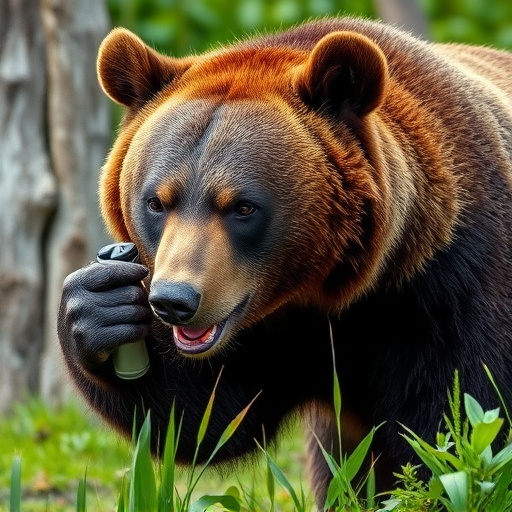Understanding grizzly bears' defensive charging behavior is crucial for self-defense in the wilderness. The optimal bear spray distance, at 20-30 feet (6-9 meters), disrupts their trajectory without closing in too much. Selecting reputable bear spray brands with cone-shaped cloud coverage ensures effective deterrence. Using the correct technique, including aiming at the bear's face and following instructions, enhances safety during potential encounters. Complementary precautions like terrain awareness, avoiding dense areas, making noise, and traveling in groups reinforce protection alongside bear spray usage.
In the vast wilderness, encountering a charging grizzly bear can be a terrifying experience. Understanding their behavior and learning effective defense strategies is crucial for adventurers and outdoor enthusiasts. This article equips you with essential knowledge on navigating dangerous encounters. We explore the science behind grizzly charging patterns, guide you through choosing the best bear spray (considering distance and effectiveness), and offer additional safety measures beyond just spray.
- Understanding Grizzly Bear Behavior and Their Charging Patterns
- Choosing the Right Bear Spray: Factors to Consider
- Effective Use of Bear Spray: Distance and Application Techniques
- Additional Safety Measures Beyond Bear Spray
Understanding Grizzly Bear Behavior and Their Charging Patterns
Grizzly bears, known for their immense strength and unpredictable nature, often charge as a defensive mechanism rather than an offensive one. Understanding their behavior is crucial when it comes to self-defense in the wilderness. When faced with potential threats, grizzlies may charge at perceived dangers, but this isn’t always an attack; it’s a way to assess the situation and decide whether to defend themselves or retreat. Their charging patterns vary based on individual temperament and context.
The best bear spray distance pattern is one that allows you to disrupt their charging trajectory without putting yourself too close. It’s recommended to use bear spray from a safe distance, typically 20-30 feet (6-9 meters), as it creates enough of an obstacle to deter the bear without inviting direct contact. This knowledge of bear behavior and effective spray usage can significantly improve your chances in a potential encounter, ensuring your safety in the wilderness.
Choosing the Right Bear Spray: Factors to Consider
When selecting bear spray, understanding the best distance pattern and factors that influence it is crucial for effectiveness in the field. Look for a product with a claimed range of 20-30 feet (6-9 meters), as this falls within an optimal distance to deter most grizzly bears without risking over-spray or inhaling the irritant yourself. The spray’s pattern should create a cone-shaped cloud that covers your escape route, providing enough time to retreat to safety.
Several key factors determine the performance of bear spray: air density and temperature (which affect dispersion), wind direction and speed (impacting trajectory), and can size (larger cans offer more shots and protection). Always choose a reputable brand that provides detailed information on its effectiveness in grizzly bear encounters, ensuring you’re prepared with the best bear spray for your needs.
Effective Use of Bear Spray: Distance and Application Techniques
When it comes to defending against charging grizzly bears, bear spray is a critical tool for hikers and outdoor enthusiasts. The best bear spray distance pattern varies depending on the type of spray and the specific bear behavior, but generally, it’s most effective when used at close to medium range. For grizzlies, aiming for a distance between 20 to 100 feet (6 to 30 meters) is ideal. This allows for sufficient time to assess the bear’s reaction and make adjustments if needed.
Application techniques are equally important. Aiming directly at the bear’s face, eyes, and nose ensures maximum impact. Many experts recommend using a “swatting” motion to spray across a wider area, which can be effective if the bear is moving quickly. Additionally, it’s crucial to follow the instructions on the product label regarding how much spray to use—under-spraying might not deter an aggressive bear, while over-spraying could waste valuable product.
Additional Safety Measures Beyond Bear Spray
When it comes to defending yourself against charging grizzly bears, bear spray is often the first line of defense recommended. However, there are additional safety measures that can significantly enhance your protection in the wilderness. While the best bear spray distance pattern varies based on factors like the bear’s size and aggression, understanding these extra precautions can prove invaluable.
One crucial measure is to ensure you’re aware of the terrain and navigate it wisely. Avoid areas with dense vegetation where bears might have a hidden advantage. Keep your distance from potential den sites or food sources known to attract bears. Making loud noises while hiking in bear country also serves as a deterrent, as bears generally prefer to avoid confrontation. Always travel in groups, as bears are less likely to attack if there’s more than one potential prey (or human). These additional safety steps complement the effective use of bear spray, providing a multi-layered defense mechanism against these formidable predators.
In conclusion, defending against charging grizzly bears requires a multi-faceted approach. Understanding bear behavior, choosing the right bear spray (considering factors like can size and active ingredients), mastering effective application techniques, and implementing additional safety measures are all crucial components. Remember, knowing the best bear spray distance pattern can mean the difference between safety and danger. Always stay alert and prepared when navigating wild landscapes.
